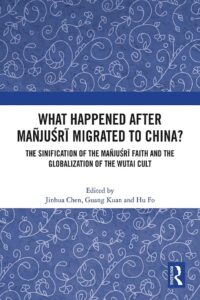 We are pleased to announce the release of What Happened After Mañjuśrī Migrated to China? The Sinification of the Mañjuśrī Faith and the Globalization of the Wutai Cult, published by Routledge.
We are pleased to announce the release of What Happened After Mañjuśrī Migrated to China? The Sinification of the Mañjuśrī Faith and the Globalization of the Wutai Cult, published by Routledge.
Book details:
Jinhua Chen, Guang Kuan, and Hu Fo, eds. What Happened After Mañjuśrī Migrated to China? The Sinification of the Mañjuśrī Faith and the Globalization of the Wutai Cult. Routledge, 2022. ISBN: 9781032073491. Price: $160 USD hardback, $53.05 ebook.
About the book:
The chapters in this book explore the transcultural, multi-ethnic, and cross-regional contexts and connections between the Buddhāvataṃsaka-sūtra, Mount Wutai and the veneration of Mañjuśrī that contributed to the establishment and successive transformations of the cult centered on Mount Wutai – and reduplications elsewhere. The contributions reflect on the literature, architecture, iconography, medicine, society, philosophy and several other aspects of the Wutai cult and its significant influence across several Asian cultures, such as Chinese, Japanese, Tibetan, Mongolian and Korean.
This book is a significant new contribution to the study of the Wutai cult, and will be a great resource for academics, researchers, and advanced students of Religion, Philosophy, History, Architecture, Literature and Art.
The chapters in this book were originally published in the journal Studies in Chinese Religions.
Table of Content:
- Foreword
Miaojiang Shi 釋妙江
The Transmission of Wutai Cult from South Asia to China
- A chemical ‘explosion’ triggered by an encounter between Indian and Chinese medical sciences: another look at the significances of the Sinhalese Monk Śākyamitra’s (567?– 668+ ) visit at Mount Wutai in 667
Jinhua Chen - Fazang’s theory of zhenru 真如 (Skt. tathatā) and zhongxing 種姓 (Skt. gotra): with a focus on the influence of the Ratnagotravibhāga
Zijie Li - Gathering medicines among the cypress: the relationship between healing and place in the earliest records of Mount Wutai
Susan Andrews
The Spread of the Wutai Cult in China: Center and Margins
- A study on a stone lantern from Dongzhang village in medieval China
Huaiyu Chen - Northern Wei Wutaishan: an outside view of centres and peripheries
T. H. Barrett - How the Mount Wutai cult stimulated the development of Chinese Chan in southern China at Qingliang monasteries
George A. Keyworth - The way of the Nine Palaces (jiugong dao 九宮道): a lay Buddhist movement
Barend J. ter Haar
The Wutai Cult in Japan
- Moving monks and mountains: Chōgen and the cults of Gyōki, Mañjuśrī, and Wutai
David Quinter - Decentering Mañjuśrī: some aspects of Mañjuśrī’s cult in medieval Japan
Bernard Faure - Representations of the Wutai Mountains in classical Japanese literature
Robert Borgen
The Wutai Cult in Tibet, Mongolia, Khotan and Korea
- Tibeto- Mongol Buddhist architecture and iconography on Wutaishan, seventeenth to early twentieth centuries
Isabelle Charleux - A visit of Christian missionaries at Mount Wutai: Mongol Buddhism from a cross-cultural perspective
Temur Temule - The Mañjuśrī cult in Khotan
Imre Hamar - Ennin’s (793– 864) Sillan connections on his journey to Mt. Wutai: a fresh look at Ennin’s travel record
Pei- ying Lin
Click here to the original posting








